Audio content is an engaging, cost-effective way to reach, retain, and convert customers, and can be used to personalize the customer experience. When done correctly, audio content can be a powerful tool for any marketing automation strategy. In this blog post, we’ll discuss how to create audio content for marketing automation, including which audio formats to use and how to optimize for each platform.
The Benefits of Audio Content

Audio content plays an important role in marketing automation by engaging customers through personalized and interactive experiences. It helps to convey brand messages, build trust and emotional connection with the audience, and provide a unique touchpoint in the customer journey.
By using audio in marketing automation, businesses can create targeted and effective campaigns that grab the attention of potential customers, leading to increased brand awareness and conversion rates. Audio content is versatile and can be used across multiple platforms such as voice assistants, podcasts, and mobile apps, offering a wide reach and accessibility to customers.
How to Create Audio Content
Here are the steps and tips for creating effective audio content for marketing automation:
- Determine your target audience and the purpose of your audio content.
- Choose the right format for your audio content, such as podcast, audio blog, or narration.
- Invest in good equipment and software to ensure high-quality sound recording and editing.
- Plan and script your content, keeping it concise, engaging, and aligned with your brand’s messaging.
- Record your audio in a quiet, echo-free environment and use a good microphone.
- Edit your audio to remove any background noise, improve sound quality, and make sure the content flows smoothly.
- Add music, sound effects, or other audio elements to enhance the listening experience.
- Promote your audio content through multiple channels, including social media, email, and your website.
- Track and analyze performance metrics, such as listens, downloads, and engagement, to continuously improve your audio content.
You can also use these tips to make your content even better:
- Speak clearly and with energy, to engage your audience and keep their attention.
- Make sure your audio is of high quality, as poor sound quality can discourage listeners from continuing to listen.
- Keep your audio content concise and focused on a single topic or message, to keep listeners engaged.
- Offer valuable insights or tips in your audio content, to make it more appealing to your target audience.
Always provide a call to action at the end of your audio content, to encourage listeners to take further action.
Types of Audio Content
Now let’s take a look at the various types of audio content.
Podcasts
Podcasts are audio recordings that can be produced and distributed online. They can be used in marketing automation by providing useful information and entertainment to potential customers and building brand awareness and loyalty. For example, a company can create a podcast series discussing topics related to their industry, and use marketing automation to send new episodes to subscribers.
Voice-over Narration
Voice-over narration involves adding a voice-over to a video or animation. This type of audio content can be used in marketing automation to provide explanations, instructions, or promotional messages in an engaging and easy-to-understand way.
For example, a company can use marketing automation to send a video that features a voice-over explaining its product or service to potential customers.
Music and Sound Effects
Music and sound effects can be used in marketing automation to create an emotional impact and enhance the overall experience for the audience. For example, a company can use marketing automation to send a promotional video that features a soundtrack that matches its brand and appeals to its target audience.
Audiobooks and Narrations
Audiobooks and narrations can be used in marketing automation to provide educational content, such as how-to guides, tutorials, or case studies, to potential customers in an engaging and convenient format. For example, a company can use marketing automation to send a narrated case study that demonstrates the benefits of their product or service.
Voice Messages and Recordings
Voice messages and recordings can be used in marketing automation to personalize communications and add a human touch. For example, a company can use marketing automation to send a recorded voice message from a representative to follow up with a potential customer after a sale.
These are just a few examples of the types of audio content that can be used in marketing automation. The key is to find the type of audio content that works best for your brand and target audience and to use marketing automation to distribute it effectively.
Best Practices for Audio Content Creation
Understanding your target audience is crucial for creating high-quality audio content that resonates with them. Consider their needs, interests, and preferences when creating audio content, and tailor it to their specific demographics.
You can also try investing in quality equipment, such as a high-quality microphone and sound recording software, which is important for creating professional-sounding audio content. The better the quality of the equipment, the more engaging and effective the audio content will be.
Before recording, it’s important to have a clear script and plan for your audio content. This will help ensure that the content is clear, concise, and on message. Consider using a storyboard or outline to plan the structure and flow of the content.
If you want to create high-quality audio content that stands out, consider hiring a professional voice actor. A professional voice actor can bring the script to life and add a level of polish and professionalism to the audio content.
Once the audio content has been recorded, it’s important to edit and refine it to ensure that it meets the desired quality standards. This may involve removing background noise, adjusting the volume and equalization, and adding sound effects or music.
Before distributing the audio content through marketing automation, test it to ensure that it is effective and resonates with the target audience. Consider conducting focus groups or surveys to gather feedback and optimize the content as needed.
By following these suggestions, you can create high-quality audio content that is effective for marketing automation and resonates with your target audience. The key is to invest time and resources into the audio content creation process to ensure that the end result is of the highest quality.
The Role of Technology in Audio Content Creation
Technology plays a crucial role in the creation of high-quality audio content for marketing automation. The right tools and technologies can help ensure that the audio content is professional-sounding, engaging, and effective for marketing automation. Here are a few key technologies that are essential for audio content creation:
Recording software: Recording software is essential for creating high-quality audio content. It allows you to record, edit and refine the audio content, and add sound effects and music to enhance the overall experience. There are many different types of recording software available, ranging from basic, free options to professional-grade software that offers advanced features.
Microphones: A high-quality microphone is critical for creating professional-sounding audio content. A good microphone will capture clear, crisp audio that is free from background noise and distortion. Consider investing in a high-quality microphone, such as a condenser microphone, to ensure that the audio content is of the highest quality.
Audio editing software: Audio editing software is essential for refining and optimizing the audio content. It allows you to remove background noise, adjust the volume and equalization, and add sound effects and music to enhance the overall experience. There are many different types of audio editing software available, ranging from basic, free options to professional-grade software that offers advanced features.
Sound effects and music libraries: Sound effects and music libraries are collections of audio files that can be used to enhance the overall experience of the audio content. They can be used to add background music, sound effects, and other audio elements to the content, making it more engaging and memorable.
Virtual assistants: Virtual assistants, such as Amazon Alexa and Google Home, can be used to distribute audio content through marketing automation. For example, a company can use marketing automation to send an audio message to a customer’s virtual assistant, which can then play the message through a speaker in the customer’s home.
Cloud-based storage and distribution platforms: Cloud-based storage and distribution platforms, such as SoundCloud and Dropbox, can be used to store and distribute audio content through marketing automation. They allow you to upload the audio content to the cloud, where it can be easily accessed and distributed to your target audience.
The Future of Audio Content in Marketing Automation
With the rise of voice-activated devices, such as Amazon Alexa and Google Home, the use of audio content in marketing automation is expected to increase. Companies will be able to reach customers through these devices and use audio content to deliver personalized messages, promotions, and other marketing materials.
Podcasting is expected to continue its rapid growth in popularity, and companies are likely to use this medium as a new way to reach their target audience. Podcasts can be used to deliver educational content, share company news, and updates, and provide behind-the-scenes glimpses into the company.
The use of AI and machine learning is expected to increase in the creation and distribution of audio content for marketing automation. These technologies can be used to analyze customer data, personalize audio content, and optimize the distribution of content for maximum impact.
The integration of audio content with virtual and augmented reality is expected to become more prevalent in the future. Companies will be able to use audio content to create immersive experiences for their customers, providing a new level of engagement and interaction.
As audio content becomes more popular, new audio formats are likely to emerge. For example, companies may use audio content in the form of short-form podcasts, audio snippets, or even audio-only advertisements.
In conclusion, the use of audio content in marketing automation is expected to continue to grow and evolve in the future. Companies that embrace these trends and invest in technology and innovation will be well-positioned to take advantage of the opportunities that lie ahead.
Wrapping Up
Creating audio content for marketing automation isn’t as hard as it may seem. With the right tools and techniques, you can create compelling audio content that will help you engage your audience and increase your reach. From podcasts to voiceovers, audio content is a valuable asset for any marketing strategy. With time and effort, you can create engaging audio content that will help you reach and engage your audience more effectively.
Try Eariously today and generate realistic Text to Speech (TTS) audio using the best synthetic voices available!





